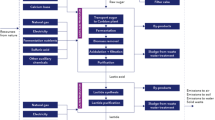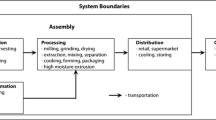Abstract
Purpose
This paper investigates different methodologies of handling co-products in life cycle assessment (LCA) or carbon footprint (CF) studies. Co-product handling can have a significant effect on final LCA/CF results, and although there are guidelines on the preferred order for different methods for handling co-products, no agreed understanding on applicable methods is available. In the present study, the greenhouse gases (GHG) associated with the production of 1 kg of energy-corrected milk (ECM) at farm gate is investigated considering co-product handling.
Materials and methods
Two different milk production systems were used as case studies in the investigation of the effect of applying different methodologies in co-product handling: (1) outdoor grazing system in New Zealand and (2) mainly indoor housing system with a pronounced share of concentrate feed in Sweden. Since the cows produce milk, meat (when slaughtered), calves, manure, hides, etc., the environmental burden (here GHG emissions) must be distributed between these outputs (in the present study no emissions are attributed to hides specifically, or to manure which is recycled on-farm). Different methodologically approaches, (1) system expansion (two cases), (2) physical causality allocation, (3) economic allocation, (4) protein allocation and (5) mass allocation, are applied in the study.
Results and discussion
The results show large differences in the final CF number depending on which methodology has been used for accounting co-products. Most evident is that system expansion gives a lower CF for milk than allocation methods. System expansion resulted in 63–76% of GHG emissions attributed directly to milk, while allocation resulted in 85–98%. It is stressed that meat is an important by-product from milk production and that milk and beef production is closely interlinked and therefore needs to be considered in an integrated approach.
Conclusions
To obtain valid LCA/CF numbers for milk, it is crucial to account for by-products. Moreover, if CF numbers for milk need to be compared, the same allocation procedure should be applied.





Similar content being viewed by others
Notes
CF is a term used to describe the total amount of greenhouse gas (GHG) emissions of a process or a product system to indicate their contribution to climate change. It also includes emissions of methane and nitrous oxide, which are of special importance for agricultural products.
The milk quota system in EU will end in 2015.
Manure and hides are also outputs, but all manure is here assumed to stay within the system boundaries (i.e. the dairy system), and hides are assumed to be of minor importance and are generally accounted for within the beef component.
The Product Category Rule (PCR) for processed liquid milk states that meat from slaughtered cows and calves “shall be omitted considering that the useful meat (kg) is negligible” (Swedish Environmental Management Council, 2010), which is here interpreted as 100% of emissions shall be allocated to milk and none to meat. In the former PCR for milk and milk-based products (Swedish Environmental Management Council, 2006), mass allocation was recommended.
References
Arsenault N, Tyedmers P, Fredeen A (2009) Comparing the environmental impacts of pasture-based and confinement-based dairy systems in Nova Scotia (Canada) using life cycle assessment. Int J Agric Sustain 7,1:19–41, ISSN: 1473–5903
Basset-Mens C, Ledgard S, Boyes M (2009) Eco-efficiency of intensification scenarios for milk production in New Zealand. Ecol Econ 68:1615–1625
Berlin J (2002) Environmental Life Cycle Assessment (LCA) of Swedish Semi-Hard Cheese. Int Dairy J 12:939–953
BSI (2008) British Standard, Department for Environment, Food and Rural Affairs, Carbon Trust. 2008. PAS 2050:2008 – Specification for the assessment of life cycle greenhouse gas emissions of goods and services. BSI, British Standard Institute, London, UK
Carbon Trust (2010) Guidelines for the Carbon Footprinting of Dairy Products in the UK. Carbon Trust Footprinting Company Limited
Cederberg C, Flysjö A (2004) Life cycle Inventory of 23 Dairy Farms in South-Western Sweden. Report No 728. SIK, the Swedish Institute for Food and Biotechnology, Gothenburg, Sweden
Cederberg C, Mattsson B (2000) Life cycle assessment of milk production – a comparison of conventional and organic farming. J Clean Prod 8:49–60
Cederberg C, Stadig M (2003) System expansion and allocation in life cycle assessment of milk and beef production. Int J Life Cycle Assess 8(6):350–356
Cederberg C, Sonesson U, Henriksson M, Sund V, Davis J (2009a) Greenhouse gas emissions from production of meat, milk and eggs in Sweden 1990 and 2005. Report No 793. SIK, the Swedish Institute for Food and Biotechnology, Gothenburg, Sweden
Cederberg C, Flysjö A, Sonesson U, Sund V, Davis J (2009b) Greenhouse gas emissions from Swedish consumption of meat, milk and eggs in 1990 and 2005. Report No 794. SIK, the Swedish Institute for Food and Biotechnology, Gothenburg, Sweden
FAO (2006) World agriculture: towards 2030/2050, Interim Report. Food and Agriculture Organization of the United Nations, Rome, Italy
Feitz AJ, Lundie S, Dennien G, Morian M, Jones M (2007) Generation of an industry-specific physico-chemical allocation matrix, application in the dairy industry and implications for system analysis. Int J Life Cycle Assess 12(2):109–117
Flysjö A, Henriksson M, Cederberg C, Ledgard S, Englund J-E (2011) The impact of various parameters on the carbon footprint of milk production in New Zealand and Sweden. Agricul Syst (in press)
Gerber P, Vellinga T, Opio C, Henderson B, Steinfeld H (2010) Greenhouse Gas Emissions from the Dairy Sector, A Life Cycle Assessment. FAO Food and Agriculture Organisation of the United Nations, Animal Production and Health Division, Rome
Högaas Eide M (2002) Life cycle assessment of industrial milk production. Int J Life Cycle Assess 7(2):115–126
Hospido A (2005) Life cycle assessment as a tool for analysing the environmental performance of key food sectors in Galicia (Spain): milk and canned tuna. Doctoral Thesis. Santiago de Compostela. Spain
IDF (2010) International Dairy Federation. A common carbon footprint for dairy, The IDF guide to standard lifecycle assessment methodology for the dairy industry. International Dairy Federation
LIC (Livestock Improvement Corporation), DairyNZ (2008) New Zealand Dariy Statistics 2007–08. Hamilton, New Zealand
IPCC (2007) Climate Change 2007. IPCC Fourth Assessment Report. The Physical Science Basis. (http://www.ipcc.ch/ipccreports/ar4-wg1.htm)
ISO (2006) Environmental management – Life cycle assessment – Requirements and guidelines. ISO 14044:2006(E). International Organization for Standardization. Geneva. Switzerland
Ledgard S, Basset-Mens C, Boyes M, Clark H (2009a) Carbon Footprint Measurement – Milestone 6, Carbon Footprint for a range of milk suppliers in New Zealand. Report to Fonterra. AgResearch, Hamilton, p 41pp
Ledgard S, Boyes M. Hutchings J (2009b) Use of LCA methodology for greenhouse gas footprinting of NZ dairy farm systems. 6th Australian Conference on Life Cycle Assessment
MAFa. Ministry of Agriculture and Forestry, International trade. (Excel file) http://www.maf.govt.nz/statistics/international-trade/ (accessed 26/01/2010)
MAFb. Ministry of Agriculture and Forestry, Livestock statistics. (Excel file) http://www.maf.govt.nz/statistics/pastoral/livestock-numbers/ (accessed 26/01/2010)
MAFc. Ministry of Agriculture and Forestry. Meat production (slaughter) statistics. (Excel file) http://www.maf.govt.nz/statistics/pastoral/slaughter-rates/ (accessed 26/01/2010)
New Zealand Dairy Statistics 2007–08, prepared by LIC and Dairy NZ, Hamilton, New Zealand. www.dairynz.co.nz/dairystatistics
PRé Consultants bv (2010) SimaPro 7, LCA software. Amersfoort. The Netherlands. www.pre.nl
Sevenster M, de Jong F (2008) A sustainable dairy sector, Global, regional and life cycle facts and figures on greenhouse-gas emissions. CE Delft, The Netherlands. Commissioned by European Dairy Association
SJV (2000) Marknadsöversikt –animalier (Market overview –animal production), Report 2000:23, Swedish Board of Agriculture
SJV (2006a) Jordbrukssttistisk årsbok 2006 (Agricultural Statistics 2006), Swedish Board of Agriculture
SJV (2006b) Djurhälsa år 2006 (Animal health year 2006), JO 25 SM 0701, Swedish Board of Agriculture
SJV (2006c) Marknadsöversikt –animalier (Market overview –animal production), Report 2006:35, Swedish Board of Agriculture
SJV. Swedish Board of Agriculture. Livestock in Sweden by type of animal. Year 1981–2009. (Excel file) http://statistik.sjv.se/Database/Jordbruksverket/Husdjur/Husdjur.asp (accessed 02/08/2010)
Swedish Environmental Management Council (2006) Product Category Rules (PCR) for preparing an Environmental Product Declaration (EPD) for milk and milk based liquid products, PCR 2006:5
Swedish Environmental Management Council (2010) Product Category Rules (PCR) for preparing an Environmental Product Declaration (EPD) for processed liquid milk, PCR 2010:12
Taurus (2005a) Kalvningsstatistik för kor (Calving statistics for cows), KAP. http://www.taurus.mu/aciro/bilddb/objektVisa.asp?Idnr=XRWcAIAYFSoIHOxK6E6NlmPLA9TDbpJuU9i6ZgrL0DTaNjt9Ilk1lBInOOee
Taurus (2005b) Kalvningsstatistik för kvigor (Calving statistics for heifers), KAP. http://www.taurus.mu/aciro/bilddb/objektVisa.asp?Idnr=gdH34bB9C40IUixSPAuTJuKEaiFn27W5FpKoGWXiOCX0OR7XDfbYiKXtL0BE
Taurus (2006) Slaktstatistik. (Slaughter statistics) http://www.taurus.mu/sitebase/default.aspx?idnr=su01K5C8AMDHDGzNQTXadbehlorv259CFCFIMPSWZcahou5CBIPVcdjq17EK
Thomassen M, Dalgaard R, Heijungs R, de Boer I (2008a) Attributional and consequential LCA of milk production. Int J Life Cycle Assess 13:339–349
Thomassen M, van Calker K, Smits M, Iepema G, de Boer I (2008b) Life cycle assessment of conventional and organic milk production in the Netherlands. Agricul Syst 96:95–107
van der Werf H, Kanyarushoki C, Corson M (2009) An operational method for the evaluation of resource use and environmental impacts of dairy farms by life cycle assessment. J Environ Manag 90:3643–3652
Weidema B (2003) Market information in life cycle assessment, Environmental Project No 863. Danish Environmental Protection Agency
Weidema B, Wesnæs M, Hermansen J, Kristensen T, Halberg N, Eder P, Delgado L (2008) Environmental Improvement Potentials of Meat and Dairy Products. JRC Scientific and Technical Reports. EUR 23491 EN −2008
Acknowledgements
The authors gratefully acknowledge the help from Mark Boyes (AgResearch, New Zealand). The study was performed with funding from the Danish Agency for Science, Technology and Innovation.
Author information
Authors and Affiliations
Corresponding author
Rights and permissions
About this article
Cite this article
Flysjö, A., Cederberg, C., Henriksson, M. et al. How does co-product handling affect the carbon footprint of milk? Case study of milk production in New Zealand and Sweden. Int J Life Cycle Assess 16, 420–430 (2011). https://doi.org/10.1007/s11367-011-0283-9
Received:
Accepted:
Published:
Issue Date:
DOI: https://doi.org/10.1007/s11367-011-0283-9




